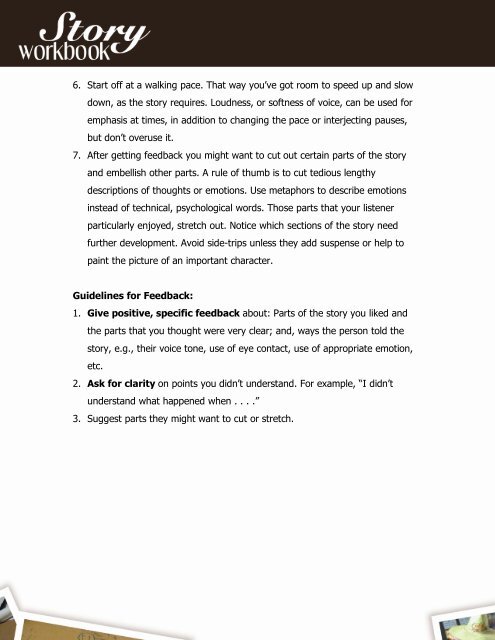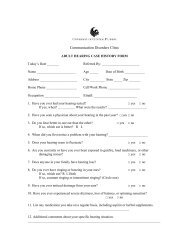SCCFP The Art of Story Telling
SCCFP The Art of Story Telling
SCCFP The Art of Story Telling
Create successful ePaper yourself
Turn your PDF publications into a flip-book with our unique Google optimized e-Paper software.
6. Start <strong>of</strong>f at a walking pace. That way you’ve got room to speed up and slow<br />
down, as the story requires. Loudness, or s<strong>of</strong>tness <strong>of</strong> voice, can be used for<br />
emphasis at times, in addition to changing the pace or interjecting pauses,<br />
but don’t overuse it.<br />
7. After getting feedback you might want to cut out certain parts <strong>of</strong> the story<br />
and embellish other parts. A rule <strong>of</strong> thumb is to cut tedious lengthy<br />
descriptions <strong>of</strong> thoughts or emotions. Use metaphors to describe emotions<br />
instead <strong>of</strong> technical, psychological words. Those parts that your listener<br />
particularly enjoyed, stretch out. Notice which sections <strong>of</strong> the story need<br />
further development. Avoid side-trips unless they add suspense or help to<br />
paint the picture <strong>of</strong> an important character.<br />
Guidelines for Feedback:<br />
1. Give positive, specific feedback about: Parts <strong>of</strong> the story you liked and<br />
the parts that you thought were very clear; and, ways the person told the<br />
story, e.g., their voice tone, use <strong>of</strong> eye contact, use <strong>of</strong> appropriate emotion,<br />
etc.<br />
2. Ask for clarity on points you didn’t understand. For example, “I didn’t<br />
understand what happened when . . . .”<br />
3. Suggest parts they might want to cut or stretch.

















